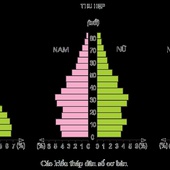Vietnam population growth 1990 - 2009
Data in this article is gathered from both the General Statistics Office of Vietnam and the World dataBank maintained by the World Bank.
In 2021, the General Statistics Office of Vietnam conducted the latest Vietnam Living Standard Measurement Survey (LSMS) aimed at evaluating population demographics and socio-economic implications. This national census, along with data gathered by international organizations such as the World Bank, provides insights into the current trends and future prospects of the Vietnamese population.
Reflecting on recent statistics, the population of Vietnam has steadily increased from approximately 66.2 million in 1990 to around 98.3 million in 2021. This figure, reported by the World Bank, highlights significant demographic growth, notably exceeding the 96.2 million recorded in the 2021 LSMS.
It is important to acknowledge that Vietnam's population has surged by more than 30 million in the past 30 years, amounting to an increase of over 45% since the 1990s. Several factors contribute to this trend. Notably, the crude birth rate, which measures the number of live births per 1,000 people per year, has seen a reduction due to increased awareness regarding population issues and the government’s active promotion of family planning initiatives.
This decline in crude birth rate coincides with a drop in the fertility rate—the average number of children born to a woman—falling from 3.53 in 1990 to approximately 2.07 in 2021. Although the number of births per woman has decreased, it is important to consider that the population of women entering childbearing age continues to grow. As a result, despite lower birth rates, the overall population continues to rise significantly.
Vietnam Birth Rate and Fertility Rate
Another crucial observation is that population growth has fluctuated over the years. The population growth rate in Vietnam fell from 2.18% in 1990 to 1.29% in 1999, before stabilizing between 1.10% and 1.15% in more recent years.
Moreover, life expectancy for both Vietnamese women and men has significantly improved over the past three decades. Men's life expectancy rose from 63.7 years in 1990 to 73.1 years in 2021, while women's life expectancy has increased even more profoundly, from 67.3 years in 1990 to 78.5 years in 2021. This demonstrates that women continue to outlive men by nearly 5.4 years, a gap that has slightly widened over the past three decades.











